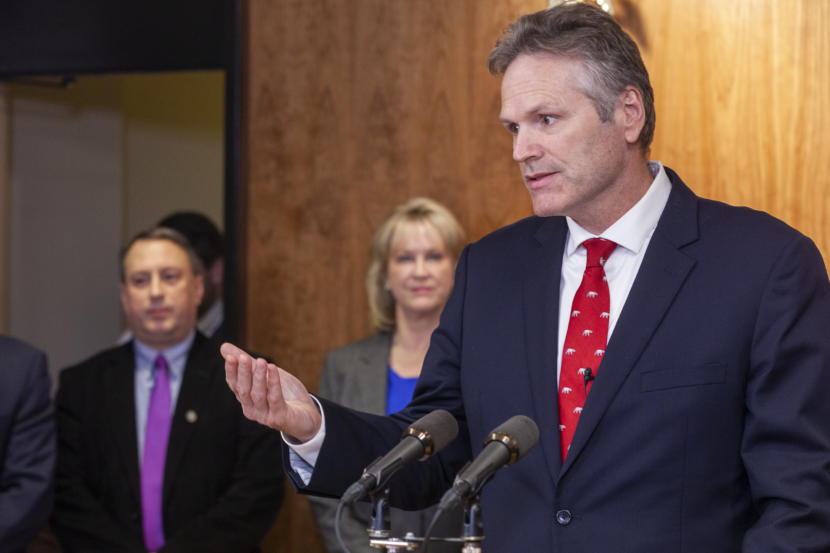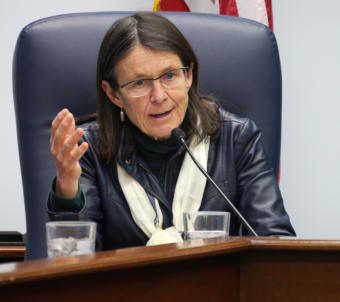
When Gov. Mike Dunleavy released his budget last week, he said the state can no longer rely on savings. He spelled out his next step: “We’re going to have to make some decisions, hard decisions, tough decisions. We began that last year. Are we going to reduce services, or do the people of Alaska want to ponder revenues?”
Dunleavy introduced a budget that would draw down most of what remains of state’s savings, other than the permanent fund: taking three-quarters of the money left in the Constitutional Budget Reserve. But deep inside another report, is also a possible framework for balancing the budget in the long run.
Its 10-year plan lays out six scenarios. Five of them rely heavily on one approach to fix the budget. For instance, different scenarios rely only on budget cuts, tax increases, cuts to permanent fund dividends, or PFDs, and drawing down the permanent fund’s earnings.
But one scenario draws on a combination of fixes — the governor’s budget office calls it the “balanced approach.” And it’s catching the attention of people who shape and analyze the budget — even as they remain skeptical.

Anchorage Republican Rep. Jennifer Johnston, House Finance Committee co-chair, is among them.
“It’s a good place to start the conversation,” Johnston said of the scenario. “But we need to have a balanced, sustainable budget. And this doesn’t do it.”
Johnston said no one strategy can fix the budget. So she likes that the so-called “balanced approach” draws on multiple strategies.
It attempts to close the budget three ways: $500 million in budget cuts; $500 million in new taxes; and $700 million in reductions to PFDs. Dividends would be lowered by changing the way they are calculated. Instead of being based on half of the recent permanent fund earnings, they would be based on the amount the state government draws from those earnings each year.
It’s the details that raise questions for Johnston. She said it would be impossible to cut $500 million without first coming up with a plan. She pointed to what’s happening with Medicaid this year. The Legislature passed $86.6 million in cuts, after the administration said they could cut more. Then Dunleavy vetoed even more funding — $58.3 million. But now, the administration says most of these cuts won’t happen.
“I’m not looking for those kinds of cuts,” Johnston said. “They’re not real cuts and they’re not ones that are sustainable. And, you know, I want some thoughtful, long-term, sustainable cuts.”
And making those kinds of cuts would take time. For instance, the largest single budget item in Alaska is public education. But Johnston said changing the formula for funding public education would likely take at least two years.
Changing the formula for calculating dividends is also complicated. Johnston said setting dividends at half of the draw of the permanent fund would leave dividends still too high to be sustainable.
She said the Legislature would get to work once the session starts in Juneau.
“It’s a starting budget,” she said. “It’s going to take all of us working together to come to something that actually at the end of the day balances and works. And so, that’s what we will be doing the first day we get down there.”
While the Office of Management and Budget laid out the broad outline of how to balance the budget in the scenarios in the 10-year plan, it didn’t say which taxes or state services should change.
Mouhcine Guettabi is an economist with the Institute of Social and Economic Research at the University of Alaska Anchorage, or ISER. He said that whatever steps the Legislature takes to balance the budget in the long run will have significant economic consequences.
Guettabi said he’s interested in understanding what the “balanced approach” scenario would mean in practical terms.
“If it provides a path that is indeed sustainable, then I think that it’s worth kind of looking under the hood, and thinking more clearly about … what does that dividend actually look like, what are the amounts, where do the taxes come from?” Guettabi said. “And where do the cuts come from?”
ISER has analyzed how cuts, taxes and dividend changes can cost the state jobs in the near term. But Guettabi said ending the state’s longstanding budget uncertainty could benefit Alaska in the long term. And the “balanced approach” scenario could be a starting point.
“Realistically, you’re going to have to do a lot of different things to get the budget to balance and to find a sustainable solution,” he said. “And this seems like a place that kind of considers all of those options — or many of the options.”
Dunleavy has said he will be holding meetings in different communities to get Alaskans’ thoughts on the budget. It’s not yet clear how the input he gets in those meetings will be translated into policy proposals.
A note of caution on the projections: The nonpartisan Office of Legislative Finance uses slightly different numbers in its computer model for projecting different budget options. It includes $120 million more in spending per year, since the state usually has to supplement what the Legislature budgets each year with additional spending. And the state is still on the hook for $700 million in cashable tax credits to oil and gas companies.
